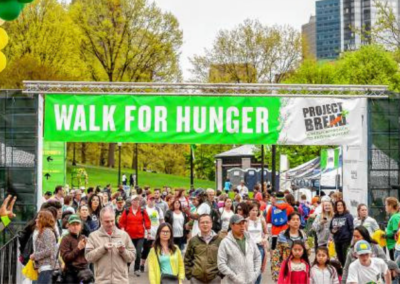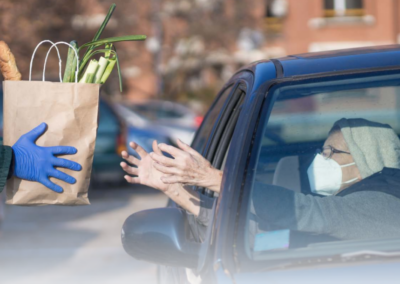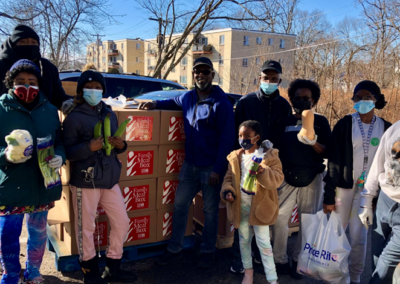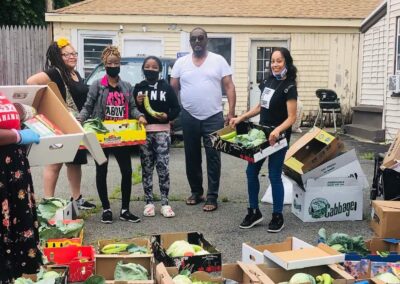Expanding Beyond Community Engagement: 5 Lessons from 5 years of the Neighborhood Food Action Collaborative (NFAC)
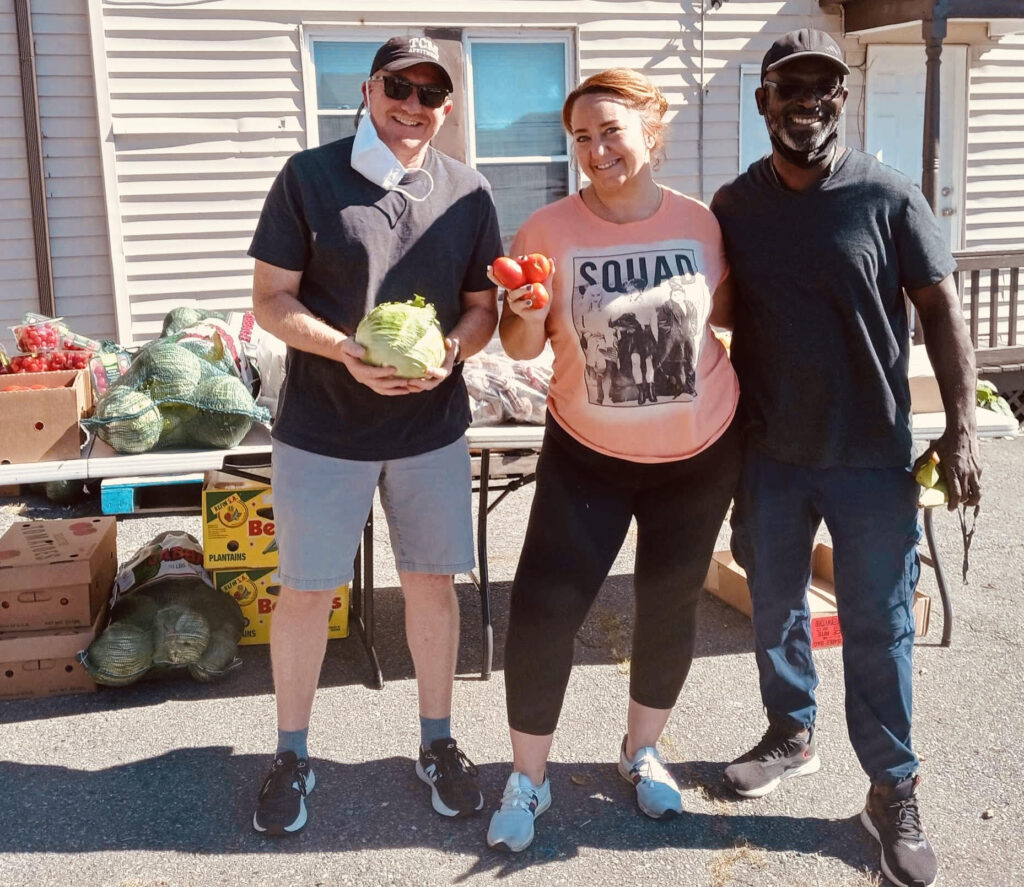

Reflections by Health Leads Director of Programs Sarah Primeau
Thousands of families in Massachusetts face daily barriers to food access in a system that’s fragmented and unjust. Communities of color are hit hardest, with Black and Latinx households experiencing food insecurity at twice the rate of white households.
But food security isn’t just about food—it’s about power. At Health Leads, we believe real food justice starts with community leadership. Our work in Boston brings together grassroots leaders, organizations, and health systems to reimagine food access—grounded in equity, driven by partnership, and rooted in the values of those most impacted. Because when communities lead, sustainable solutions grow.
Since 2020, we have applied our systems change approach to create a community-driven model anchored on racial health equity through the creation of The Neighborhood Food Action Collaborative (NFAC). Serving as the co-backbone organization for NFAC along with Vital CxNs, Health Leads works with partners and residents to increase the availability of affordable, nutritious, and culturally appropriate foods in the Boston area.
Five years ago, I stepped into this work — not knowing just how much it would shape me. From day one, this journey has been rooted in community, complexity, and constant learning. Now, I’m pausing to reflect on five lessons that have stayed with me—the ones that challenged, stretched, and ultimately transformed the way I show up in systems change efforts.
1. Bridging Urgency Around Immediate Needs and Systemic Impact
My work with NFAC has taught me one of the most complex lessons: how to meet immediate community needs while still building sustainable, systemic change. It’s a constant balancing act. Simultaneously doing upstream and downstream work isn’t easy, and it means navigating limited resources, shifting policies, and the pressure to deliver results. But if there’s one thing I’ve learned, it’s this: we can’t fix the system without first addressing the immediate need. Meeting urgent food needs is non-negotiable—but it’s only half the work. It is our job to uplift insights from the community—what’s working, what’s missing, what’s broken—that guide us toward system improvement. It’s about balancing fresh food distribution (NFAC supports three community-owned food distribution programs) with co-designing culturally responsive programming (SNAP outreach, nutrition education, and youth engagement programs), while supporting community leaders so their voices are influencing policy decisions and they have pathways for economic development to lead community improvement efforts and earn living wages. The balance is hard, but it’s where real change begins.
2. Investing in Local Leadership for the Long Run
Supporting community members in becoming the leaders they already are isn’t about creating something new—it’s about making space, building trust, and investing in a long-term shift in power. Too often, leadership development gets reduced to a checklist—host a training or focus group, share resources, and move on. But building community power and leaders doesn’t work like this – and checking a box rarely shifts the ground beneath it and actually has the potential to result in less informed solutions that cause harm. The strongest change agents in a community are the individuals directly impacted by the current conditions and they should have a powerful stake in redesigning the system that impacts their own health. Honing leadership from within the community where it already exists means creating the environment for growth, offering meaningful training, and surrounding leaders with the support they need to gain additional skills. But this kind of transformation doesn’t happen overnight. It takes time to build trust, capacity to offer consistent support, and sustained investment to ensure long-term impact. It also takes the right partners—organizations willing to share knowledge, invest resources, open doors, and share power by walking alongside communities as they build power from the ground up.
My partner in this work, Senior Community Leader Ric Henry, is the glue and the soul of NFAC. His unwavering connection with the community keeps people deeply engaged, and his leadership and ability to hold me accountable to continuously show up, push boundaries, and ask deeper questions about how I’m using my own influence to shift power has been invaluable. He has shown me that real investment means being willing to challenge the systems that created the need for this work in the first place—and partnering with the community to rebuild together.
3. Building the Bridges That Matter and Last
In many cities, resources exist—but what’s missing are the connections and partnerships to ensure the most marginalized communities can access them equitably and effectively. Real impact comes from weaving together the people, organizations, and systems that too often operate in silos. One of the biggest lessons I’ve learned is that real coordination and collaboration only happen through relationships built on mutual benefit and trust. It’s not just about aligning goals—it’s about investing the time and capacity to truly understand each other’s work. It means having an intentional deep focus on coordination and collaboration in our community network meetings so we have strong relationships between our wide range of partners across health systems, government agencies, mutual-aid groups, community-based organizations and local residents.
4. Holding the Container, Not the Power
What I’ve come to understand is that being a strong backbone means knowing when to lead, when to support, and when to step back—creating the scaffolding for community ownership to thrive well into the future. In the beginning, as a backbone we leaned heavily into leading the work, but as time went on, we recognized we needed to shift into a supporting role, focusing on co-designing every step alongside community members and partners. By our fourth year, we were anticipating to step back, but a community-led sustainability planning process unveiled a clear message: for the work to endure, it must remain community-driven, supported by a backbone that provides structure, but doesn’t hold power. To be honest, this wasn’t what I initially envisioned. But that’s not what the community asked for — they wanted backbone support in a new, more locally grounded form. That insight reshaped our path forward, and we’re now going through a transition process driven by the Community Leaders that creates a supportive backbone structure that honors community leadership, while ensuring strong, ongoing infrastructure.
5. Embracing the Messy, Necessary Work of Shifting Power
Let’s be honest—shifting power isn’t a clean, linear process. It’s messy, uncomfortable, and full of hard lessons. With NFAC, at times, I got caught up in deliverables and timelines, forgetting to pause and ask myself: Are we truly listening to the community? Are we still aligned with our purpose? Is this work truly community-led? What helped me stay accountable was having checks and balances built into our process: my own colleagues, diverse partners, community leaders, and organizations who weren’t afraid to speak up and ask hard questions. As an organization, we had to be flexible and willing to pause, reflect, and listen—really listen to the community. For many, this runs counter to how many programs are “typically” run and requires a shift in thinking of what it means to lead. Ceding power, and creating space to seed it within community requires humility, self and organizational reflection, and breaking down of traditional norms and assumptions of how programs are “supposed” to run. It means handing over power and control. It can’t be rushed and it truly requires us to move at the speed of trust. Without it, we risk replicating the very inequities we’re trying to dismantle.
What’s Next?
Five years ago, I walked into this work thinking I had community engagement all figured out – and I was wrong. Working with Ric and NFAC completely shifted my perspective. I learned that our systems aren’t designed to put power in the hands of communities. And if we’re not intentional, it’s all too easy to fall into the trap of driving the bus instead of building it with the people who are meant to steer it. But I also witnessed firsthand how community-rooted leadership—when trusted and resourced—can transform local food systems through innovation and culturally relevant access support.
At Health Leads, we remain deeply committed to building on the lessons from this work to drive deeper, more community-led change. Our next phase of work will focus on advancing community power and co-design through innovative approaches at the intersection of community health workers (CHWs) and Food is Medicine. Curious where this work is headed next? Let’s talk.

